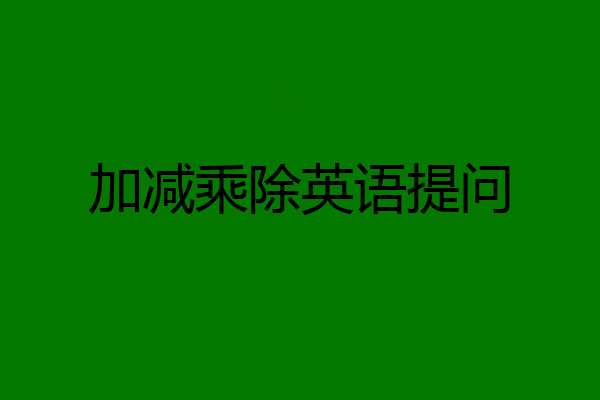
dp24044979
1、【加法】+号
在英语里一般用这三个:①and②plus③add
例:Seven and/plus eight makes fifteen.7加8等于15。If you add tento eight,you get eighteen.10加8等于18。
1、【减法】-号
在英语里一般用这三个:①minus②from③take(away)(from)
例:Eight minus five is(leaves)three.8减5等于3。/8减5余3。注:在减法里,=也可以用leaves,同汉语里的“余”4 from20 leaves 16.20减4余16。Ten take awayfour is six.10减去4得6。
3、【乘法】X号
在英语里一般用这两个:①times②multipliedby
例:Five times three is/equals fifteen.5乘以3等于15。Fivemultiplied bytwo equals ten.5乘以2等于10。
4、【除法】÷号
在英语里一般用这两个:①divided by②into
例:Twelve divided by four makes three.12除以4等于3。Four intotwelve is three.
其他的英文数学符号表达
1、正负号±
plus-minus sign 正负号
“±1” 读作:plus or minus one
2、等于号=
equals; is equal to 等于号
“1+1=2”读作:One plus one equals two.或 One plus one is equal to two.
3、不等于号≠
is not equal to 不等于号
“a≠b”读作:a is not equal to b
4、百分号%
percent 百分之……
“10%”读作:ten percent
5、括号()
parentheses [pəˈrenθəsɪs] ; brackets [ˈbrækɪt]; round brackets 括号


达宝利姜广丛
加、减、乘、除的英文如下:
1、加:用and、plus、added to 等词表示。
2+4=6可译为:
Two and four is six.
Two plus four is equal to six.
Two added to four equals six.
2、减:用minus、taken from、subtracted from等表示。
8-3=可译为:
Eight minus three is five.
Three taken from eight leaves five.
Three subtracted from eight leaves five.
3、乘:用multiply by、multiplied by、time等表示。
3 × 5 = 15可译为:
Multiply three by five is (gives)fifteen.
Three multiplied by five is fifteen .Multiply three by five , you get fifteen.
Three times five is (makes, will be , equals, is equal to ) fifteen.
4、除:用divided by、divide into、into等表示。
24 ÷ 8 = 3可译为:
Twenty-four divided by eight is equal to three.
Eight into twenty-four goes three times.
Divide eight into twenty-four , and you get three.
简单数学等式的英语表达
大于>:is greater than
大于等于(不小于)≥:is more than or equal to / is no less than
小于<:is less than
小于等于(不大于)≤:is less than or equal to / is no more than
不等于≠:is not equal to
等于=:equals
例句:
1、12+36=48:Twelve plus thirty-six is forty-eight.
2、10-4=6: Ten minus four is six. / Ten minus four equals four.
3、5×5=25:Five times five is twenty-five.
4、20÷4=5:Twenty divided by four is five.
5、5>1:Five is greater than one.
6、7+4≥10: Seven plus four is equal to or greater than ten.
7、1≤8:One is less than or equal to eight. / One is no more than eight.
8、1≠0:One is not equal to zero.

PK从来没赢过
“加”用 plus,and 或 add 表示减 ”用 minus 或 take from 表示“乘”用time(动词)或multiply表示“除”用divide的过去分词形式表示

习习谷风
1、plus 英[plʌs] 美[plʌs]
prep. (表示运算) 加; (表示包容) 外加; [口语] 和; (表示数目) 在零(度)以上;
n. 加号; [数学] 正量; 好处; 附加物;
adj. 加的; 正的; 附加的; 比所示数量多的;
[例句]Send a cheque for £ 18.99 plus £ 2 for postage and packing
请寄上18.99英镑的支票,外加2英镑的邮资和包装费。
2、minus 英[ˈmaɪnəs] 美[ˈmaɪnəs]
prep. (表示否定) 没有; 缺少; (表示运算) 减去; (表示数目) 在零度以下;
n. 减号; 负号; 不利; 不足;
adj. 负的; 不利的; 略低于某标准的;
[例句]One minus one is zero
1减1等于0。
3、multiply 英[ˈmʌltɪplaɪ] 美[ˈmʌltəˌplaɪ]
vt. 乘; (使) 相乘; (使) 增加; (使) 繁殖;
adv. 多样地; 复合地; 多倍地; [电学] 并联地,多路地;
adj. 多层的; 多样的; 多股的;
[例句]Such disputes multiplied in the eighteenth and nineteenth centuries
这类纠纷在18和19世纪大量增多。
4、division 英[dɪˈvɪʒn] 美[dɪˈvɪʒən]
n. 部门; 分开,分隔; [数] 除法; [军] 师;
[例句]The current division of labor between workers and management will alter.
当前工人与管理部门的分工将会改变。

海狸鼠小姐
在提问加减乘除得数时,如用howmuch,谓语动词多用单数形式;如用howmany,谓语动词多用复数形式。eg:howmuchiseightdividedbytwo?howmanyaretwotimesfive?”但是英语中howmuch通常用于询问价钱,对加减乘除的提问通常是用whatis...加法:whatisaandb?或whatisaplusb?减法:whatisaminusb?乘法:whatisabyb?除法:whatisadividedbyb?

多彩装修
加 plus介词 prep. 1. 加,加上Five plus two equals seven. 五加二等于七。 2. 外加;另有The work of an engineer requires intelligence plus experience. 工程师的工作需要才智,还要经验。 形容词 a. 1. 【数】表示加的;正的[B]5 is a plus quantity. 五是一个正数。 2. 比...略好一些的;比...略高一些的[A]She got a grade of B plus. 她的成绩是B+。 3. 【口】外加的;特别的 4. 【口】有利的;有益的[B]His experience in social work is a plus factor. 他在社会福利工作方面的经验是一个有利因素。 5. 【电】阳性的;正电的[B] 名词 n. [C]1. 【数】加号,正号;正数,正量You need a plus there. 你那儿需要一个加号。 2. 外加额;附加物 3. 好处;有利因素[(+for)]His new job has several pluses, one of which is a large salary. 他的新工作有几个好处,其中之一是薪减 minus介词 prep. 1. 减(去)10 minus 5 leaves 5. 十减五剩五。 2. 【口】没有,失去The statue survived though minus a leg. 那尊塑像保存了下来,但缺了一条腿。 形容词 a. 1. 负的,减去的[B]The temperature is now minus 5 degrees. 现在气温为零下五度。 2. 略低一点的,略差一些的[A]I got an A minus. 我得了一个A-。 3. 不利的[B]A boy might live in a minus neighborhood but not be a delinquent. 一个男孩子可以生活在一个差劲的街坊而不沦为罪犯。 名词 n. [C]1. 【数】负号,减号;负数,负量There is a minus before the number to be subtracted. 在要减去的数字前有一个减号。 2. 不足,缺陷Traffic noise is one of the minuses of living on a main road. 车辆的噪音是住在交通干道旁的不利乘 multiplymultiply1及物动词 vt. 1. 乘,使相乘[(+by/together)]Four multiplied by five is twenty. 五乘四得二十。 2. 使(成倍地)增加Such examples could be multiplied indefinitely. 这样的例子不胜枚举。 3. 使繁殖Hot weather multiplied the bacteria in the food rapidly. 炎热的天气使食品中的细菌迅速繁殖。 不及物动词 vi. 1. 增加As we climbed up the mountain, the dangers and difficulties multiplied. 我们越向山顶攀爬,危险和困难越是倍增。 2. 繁殖Rabbits multiply quickly. 兔子繁殖很快。 3. 做乘法He learned to multiply at the age of five. 他五岁学会做乘法。 multiply2形容词 a. 1. 多层的,多股的副词 ad. 1. 多样地;多重地除 divide及物动词 vt. 1. 分,划分[(+into/from)]The teacher divided our class into four groups. 老师把我们班分成四个小组。 2. 分发;分享[(+between/among/with)]The children divided up the candy among themselves. 孩子们把糖果分吃了。 3. 分配[(+between)] 4. 【数】除[(+by/into)]12 divided by 4 equals 3. 十二除以四等于三。 5. 使对立,分裂We shall not let such a small matter divide us. 我们决不会让这么一个小问题分裂我们。 6. 使分开,使隔开[(+from)]A wall divides our garden from theirs. 一道墙把我们的花园和他们的隔开。 不及物动词 vi. 1. 分开We divided into two groups. 我们分成两组。 2. 分裂;意见分歧The Board of Directors divided on the new project. 董事会对这个新计划意见分歧。 名词 n. 1. 分歧,不和[S][(+between)]There is a deep divide between the two factions. 这两派之间有很深的分歧。 2. 分水岭[C]

单色的星空
How much how much与how many的区别在于:how many 后接可数名词复数形式,而how much 后接不可数名词。例如: -How many people are there in your family?你家有几口人? -There are five.五口人。 -How many birds can you see in the picture?图画中你能看见多少只鸟? -Only one.仅看见一只鸟。how much 是一个常见的特殊疑问词组,它的意思为“多少”,表示数量,其后面接不可数名词,也可单独使用,它在初中课本里的用法主要有: 1、用来询问事物的数量,后接不可数名词。例如: How much milk is there in the glass?玻璃杯里有多少牛奶? How much bread is there on the table?桌子上有多少面包? 2、用来询问事物的重量。例如: -How much do you want to buy? 你想要买多少? -Two kilos.两公斤。 -How much does the pig weigh?这头猪多重? -Eighty kilos.八十公斤。 3、用来询问数字计算的结果,相当于what。例如: -How much is three plus one?三加一等于多少? -It's four.等于四。 -How much is eight minus three?八减三等于多少? -It's five.等于五。 4、how much 意为“多少钱”时,可单独使用,也可构成词组how much money,但英语中常省略money,用来询问某物的价钱、价格。例如: How much is your new computer?你的新电脑多少钱? How much (money ) did you pay for the English grammar book?买这本英语语法书,你付了多少钱? 注意:(1)how much 后接be动词时,be 是单数还是复数,取决于be之后的名词。例如: -How much are the parrots?这些胡萝卜多少钱? -Two yuan a kilo.两元一公斤。 -How much is this coat ?这件大衣多少钱? -One hundred and fifty-three yuan. 一百五十三元。 (2)how much询问价格时,它的回答若是中国的货币单位应采用汉语拼音yuan,fen来表示,几角常采用几十分来表示,字母用小写,且不用复数。例如: -How much is the eraser?这块橡皮擦多少钱? -Ninety two fen.九角二分。 (3)在买卖过程中,买方觉得太贵不买,常用That's much too dear.作答。如果觉得比较合适,常用That's (very,quite cheap.
优质英语培训问答知识库